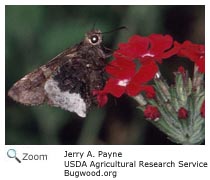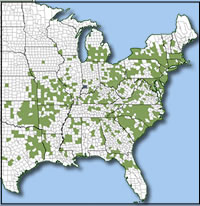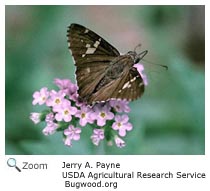Hoary Edge - Achalarus lyciades |
||||||||
Description
Range |
HabitatThe hoary edge is found in open woodlands and brushy areas with oak and pine trees and sandy soil. It is also found in meadows, gardens, and on roadsides. Diet Life Cycle
The male hoary edge selects a spot on a tree or shrub 3-6 feet above the ground, perches, and waits for a female. He defends his spot from other males and gives chase if one gets too close! The female lays one egg at a time on the underside of a leaf. In the northern part of its range, the hoary edge produces one brood a year. In the southern part of its range, it produces two broods a year. The
larvae have a black head and a green body with yellowish-orange dots. |
|||||||


 The hoary edge is found from Minnesota east to New Hampshire and south to Texas and Florida.
The hoary edge is found from Minnesota east to New Hampshire and south to Texas and Florida.